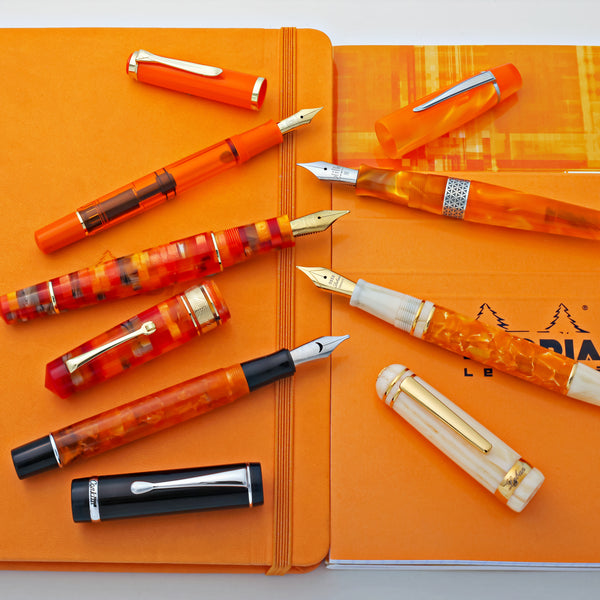Using the wrong ink.
Just because there's a colorful fluid inside of a bottle that calls itself "ink" does not mean it is suitable for fountain pens. India inks and calligraphy inks are damaging to fountain pens. We can't say it enough - we strongly advise against using India inks or calligraphy inks in fountain pens. Such ink will cause your ink flow to clog the feed. If you accidentally used India ink in your pen, use a fountain pen flush like this one from Monteverde to soak and rinse out the nib and feed. In the future, make sure you pick a suitable fountain pen ink. They will often say "fountain pen ink" on the label. There are over a thousand bottles to chose from on Goldspot.com.
Using the wrong paper.
Paper is such an important element of the writing experience, yet it's often the most overlooked. Much of the attention goes to the pen design and the colorful ink. Yet, neither of those matters when you use whatever paper is laying about. On recycled paper, fountain pen ink will feather, bleed through, and make your writing look a sloppy mess.
When you invest in your writing setup, make sure to include fountain pen-friendly paper. Rhodia notepads, Clairefontaine notebooks, and Tomoe River Journals all have suitable papers.
If you are at the mercy of whatever paper is supplied at the office or school where you do the majority of your writing, then I would suggest using ink like Noodler's X-feather which resists feathering on low-quality papers.
Leaving a pen inked and forgotten in a drawer, bag, or cup
Do you throw your inked fountain pens in a cup, drawer, or bag, only to be forgotten for weeks or months? Not only might the ink dry out, but your pen might be clanging together with other pens, keys, coins, and so on, marring the precious finish of your pen. Protect your pens by storing them in a case or sleeve. Also, don't have too many pens inked at one time. Make sure each pen has the love and attention it deserves.
Not completely submerging the nib into ink when filling
Does your pen suck and sucking up ink?
When you fill a typical fountain pen using bottled ink, make sure the nib is fully submerged up to where it meets the section. If you dip it halfway, you won't get the suction to bring ink into the pen. Sure, you might be able to write for a few sentences or a page. Then, the pen will stop flowing ink because there's nothing in the reservoir.
Watch >> How to fill a fountain pen using a converter.
Not waiting for the ink to flow after installing a cartridge
Fountain pens teach you to slow down and appreciate the writing experience - starting with filling the pen. If your pen is not writing immediately after plugging in an ink cartridge, have patience! The ink needs time to saturate the feed. You can encourage the process by gently squeezing the ink cartridge to feed ink to the nib.
Watch >> How to fill a fountain pen using an ink cartridge.
Springing the nib by pressing too hard
Fountain pens are not the same as ballpoint pens. The nib only needs light touch on paper. Pressing hard will cause the tines to splay, resulting in permanent damage to your nib. Be kind to your tines. Write gently.
Pulling off a screw cap
Don't wreck your pen by pulling a screw-off cap. You have a better than average chance that the fountain pen uses a screw-off cap and it won't harm a pen if you accidentally attempt to unscrew a pull-off cap. When it doubt, unscrew, don't pull.
Cleaning the pen with alcohol/acetone
In today's world, we're more conscious than ever about cleaning and disinfecting everything. Before you start wiping your pens with antimicrobial chemicals, it is unforgivable if you clean your pen with agents like isopropyl alcohol or acetone. You will destroy your pen.
To be on the safe side, use plain old soap and water.
Find out more about cleaning your fountain pens here.
Eyedropper converting a pen that is not eyedropper convertible.
Eyedropper converting a pen can expand a pen's ink capacity and allow you to use bottled ink whereby the pen might only accept cartridges. However, not all pens are eyedropper convertible. Any pen that has metal parts in the interior of the barrel should not be eyedroppered. For example, eyedroppering a Kaweco classic sport, which is made of injection-molded resin, is perfectly fine to do. If you eyedropper a Kaweco AL-Sport, which is made of aluminum, the threading that connects the barrel and grip section will degrade and might even fuse together. Before eyedroppering, consult the hive mind of pen enthusiasts online and check to find the results of those who have already tried it.
Underestimating the callousness of pets and clumsiness of children.
Pets and small children are part of life's deepest joys. However, they can also cause great destruction to your pens and inks. Do not underestimate the callousness of animals and the carelessness of children. Make sure pens and inks are safely out of their reach.
Rolling off the table
Just like a smartphone, a fountain pen is not immune to drops. Since you can't put an Otterbox case on a fountain pen nib, if your pen rolls off the table, your nib might end up a wreck of twisted metal. When your pen is not in use, put the cap back on. If the cap has a clip or roll stop, it will prevent the pen from rolling. If your pen does not have a clip, put it in a pen holder or pen case.
Now that you know about the most egregious offenses toward fountain pens, I'd love to read what blunders you made. Share them in the comments so that others may avoid such grisly fates.



